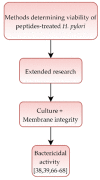Transformation of Helicobacter pylori into Coccoid Forms as a Challenge for Research Determining Activity of Antimicrobial Substances
- PMID: 32143312
- PMCID: PMC7157236
- DOI: 10.3390/pathogens9030184
Transformation of Helicobacter pylori into Coccoid Forms as a Challenge for Research Determining Activity of Antimicrobial Substances
Abstract
Morphological variability is one of the phenotypic features related to adaptation of microorganisms to stressful environmental conditions and increased tolerance to antimicrobial substances. Helicobacter pylori, a gastric mucosal pathogen, is characterized by a high heterogeneity and an ability to transform from a spiral to a coccoid form. The presence of the coccoid form is associated with the capacity to avoid immune system detection and to promote therapeutic failures. For this reason, it seems that the investigation for new, alternative methods combating H. pylori should include research of coccoid forms of this pathogen. The current review aimed at collecting information about the activity of antibacterial substances against H. pylori in the context of the morphological variability of this bacterium. The collected data was discussed in terms of the type of substances used, applied research techniques, and interpretation of results. The review was extended by a polemic on the limitations in determining the viability of coccoid H. pylori forms. Finally, recommendations which can help in future research aiming to find new compounds with a potential to eradicate H. pylori have been formulated.
Keywords: H. pylori; antibacterial therapies; coccoid forms; morphological transformation.
Conflict of interest statement
The authors declare that they have no conflict of interest.
Figures







References
-
- Hooi J.K.Y., Lai W.Y., Ng W.K., Suen M.M.Y., Underwood F.E., Tanyingoh D., Malfertheiner P., Graham D.Y., Wong V.W.S., Wu J.C.Y., et al. Global Prevalence of Helicobacter pylori Infection: Systematic Review and Meta-Analysis. Gastroenterology. 2017;153:420–429. doi: 10.1053/j.gastro.2017.04.022. - DOI - PubMed
Publication types
Grants and funding
LinkOut - more resources
Full Text Sources

